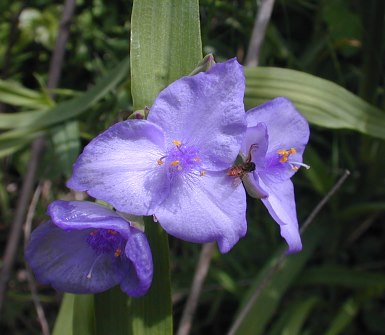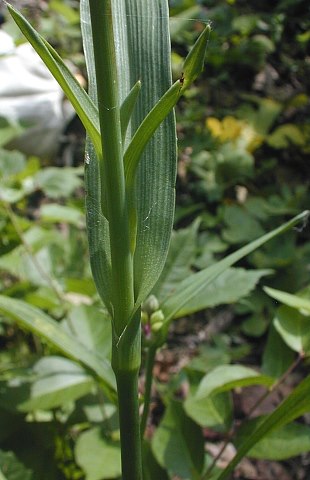Description: This herbaceous perennial plant is up to 2½' tall and unbranched, except for 1 or 2 small side stems near the inflorescence. The central stem is round and glabrous, although scattered long hairs may occur where the leaves wrap around the stems, or a little below. The leaves are dark green or olive green, up to 12" long and 1" across, with parallel venation and smooth margins. They are linear to broadly linear, but wider at the base and narrowing to a pointed tip. They often bend downward toward the middle.

At the apex of the
central stem or side stems, is a small cluster of violet flowers. They
often droop from their slender hairy pedicels. These are subtended by
two leaf-like bracts that are up to 6" long and slightly more than ½"
across. Each flower is about 1" across and has 3 rounded violet petals.
Toward the center, there are 6 yellow stamens and spidery violet hairs.
Each flower opens up during the morning and closes during the early
afternoon on sunny days, but may remain open longer on cloudy days or
when it remains in the shade. There is no floral scent. The blooming
period occurs from late spring to mid-summer, and lasts about 1½
months. During this time, the flowers bloom sporadically, rather than
all at once. The seed capsules split open into 3 parts, each releasing
3-6 oval to oblong, brown seeds. The seeds normally fall only a short
distance from the mother plant. The root system is fleshy and fibrous,
producing occasional offshoots nearby.

Cultivation:
The preference is partial sun and moist to mesic conditions. It also
tolerates light shade, and full sun if the soil is sufficiently moist.
Growth is best in fertile loamy soil, but some sand or gravel is
acceptable. During droughts, the tips or outer lengths of the leaves
may turn yellow or brown. This plant is easy to grow and rarely
troubled by foliar disease.
Range & Habitat:
The native Virginia Spiderwort is fairly common in central and southern
Illinois,
while it is uncommon or absent in northern and extreme western Illinois
(see Distribution
Map). Habitats include moist to mesic black soil prairies,
sand prairies, savannas, thickets, openings and edges of woodlands,
sandstone cliffs, and powerline clearances through woodland areas. This
plant usually doesn't stray far from areas with trees and shrubby
vegetation.
Faunal Associations:
Bumblebees are the most important pollinators of the flowers. Other bee
visitors include honeybees, Little Carpenter bees, and Halictine bees.
Syrphid flies also visit the flowers, but they feed on stray pollen and
are not effective pollinators. A leaf beetle (Lema collaris)
feeds on the foliage. Various herbivores eat the leaves and stems of
this plant occasionally, including deer, livestock, rabbits, and the
wood tortoise.
Photographic Location:
The photographs were taken at Busey Woods in Urbana, Illinois.
Comments:
Virginia Spiderwort can be readily distinguished from Ohio Spiderwort
by the hairiness of its slender pedicels. However, hybrid plants with
Virginia Spiderwort as one of the parents can escape from cultivation;
they may or may not have hairy pedicels. Virginia Spiderwort also has
larger bracts subtending the flowers than Ohio Spiderwort, and it tends
to be shorter with stouter leaves that don't have bluish tints. White
flowers can be produced by plants in the wild, but this is very rare.
Other color variations are available through market hybrids. The leaves
and stems are supposed to be edible – fresh or cooked.